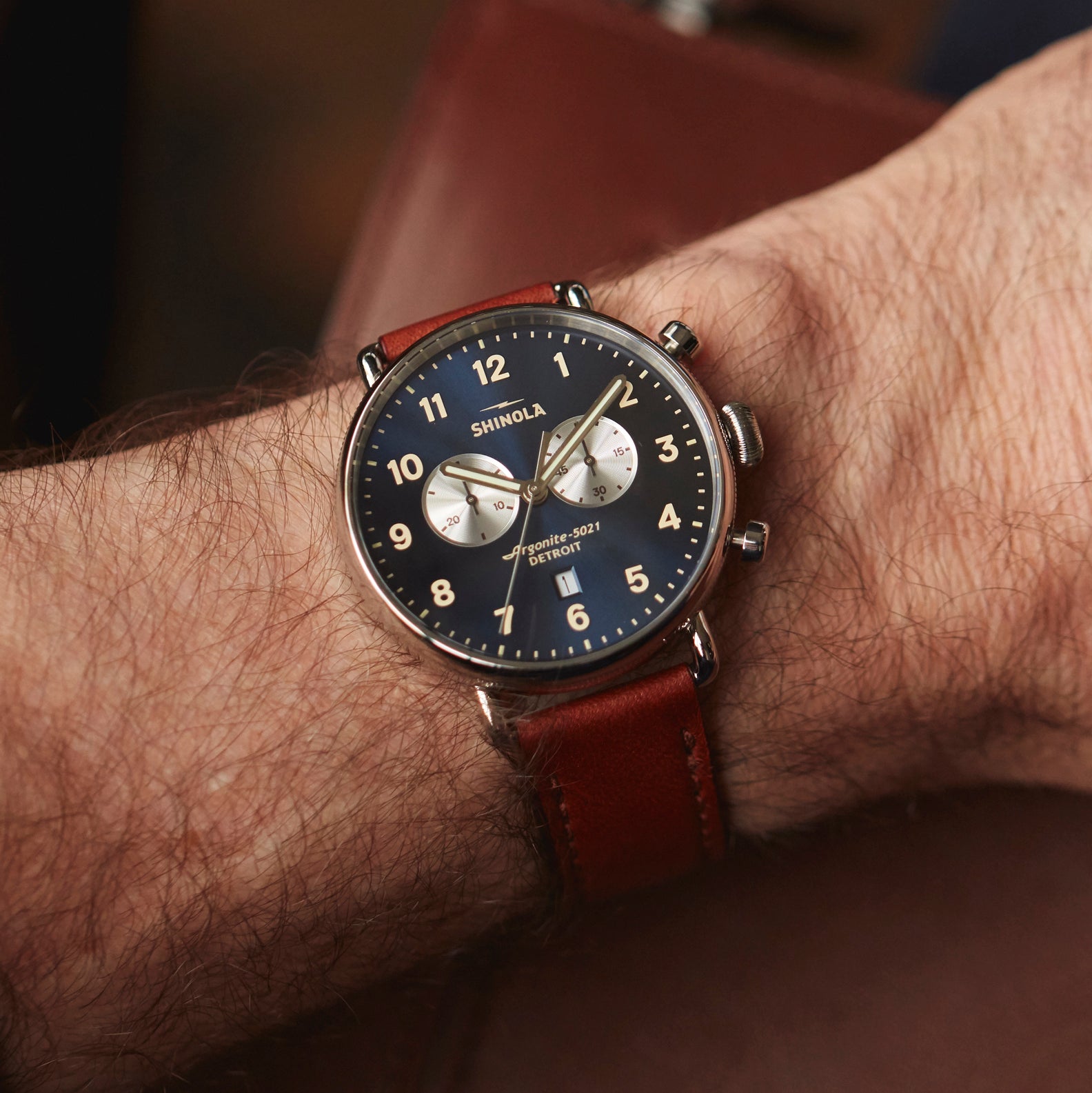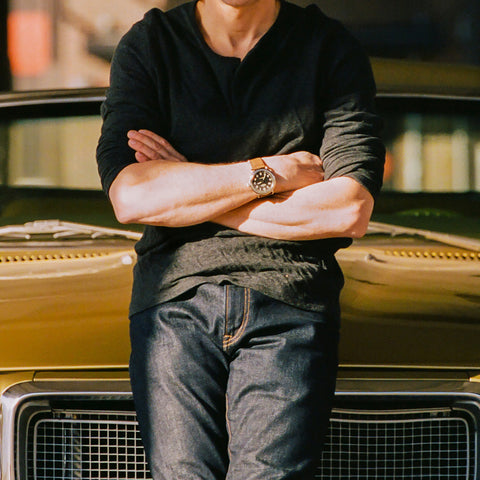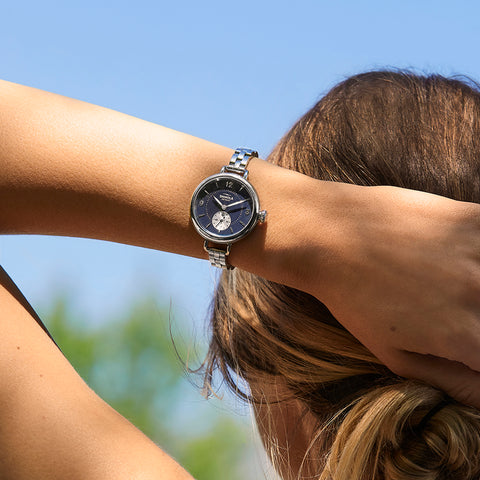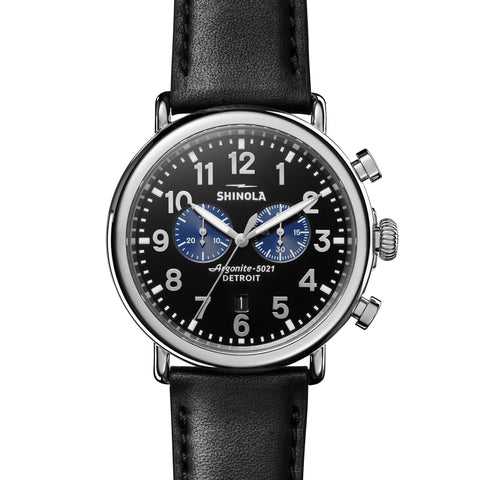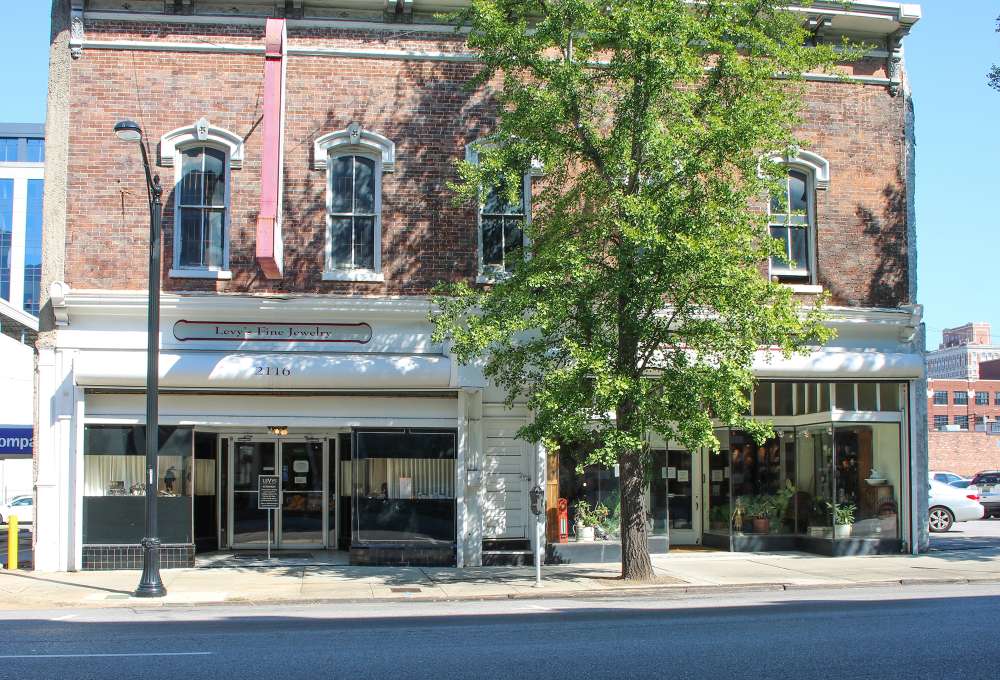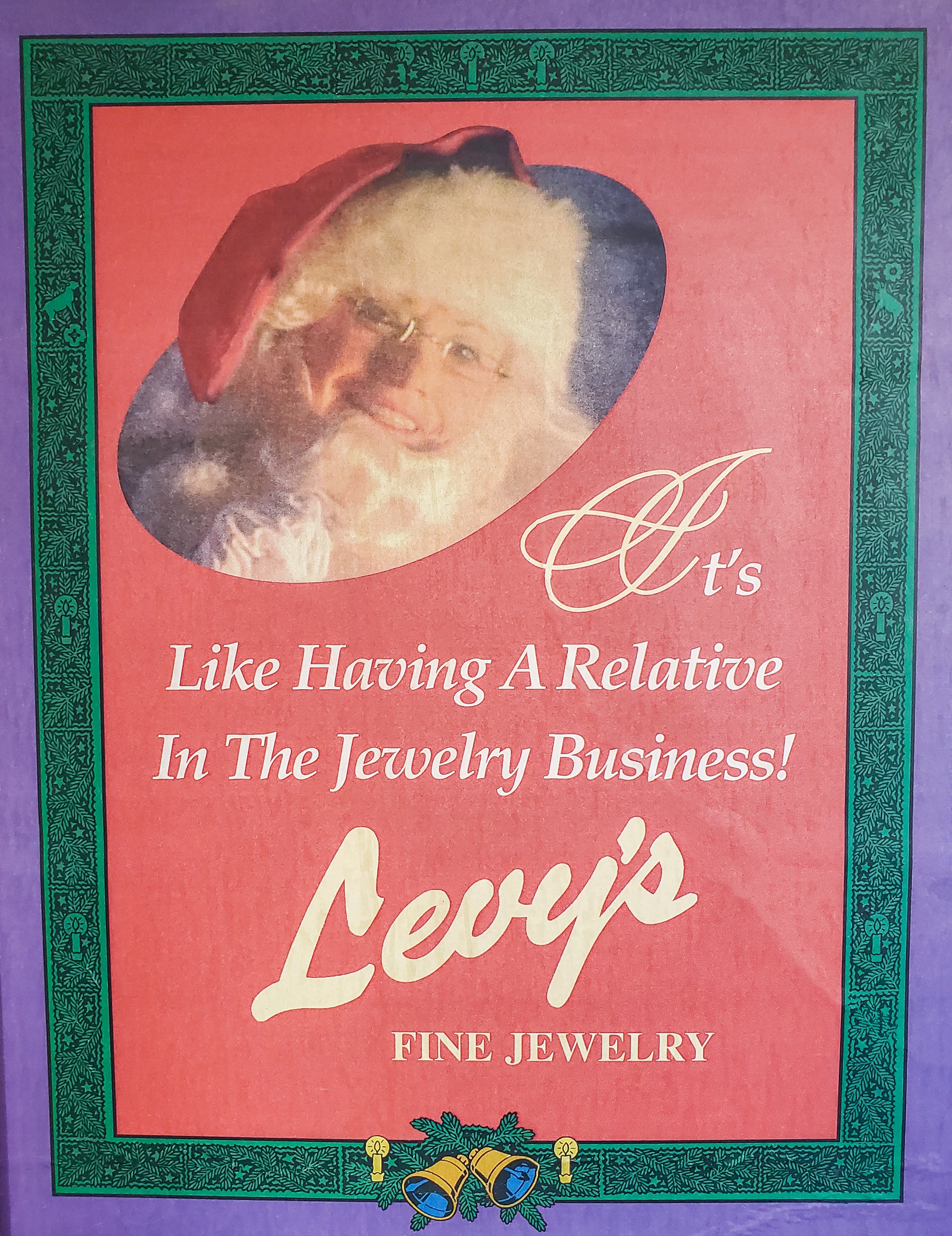
The Victorian era was a time of elegance, refinement, and an intricate language of symbolism. This was particularly evident in the realm of jewelry, where fashion becomes even more personal. While today, we may be used to women buying jewelry for themselves for no other reason than because they love the way it looks, that was not a mindset the average Victorian woman would have understood. To them, jewelry was rare and valuable, and each piece should be special and symbolic of some greater meaning other than beauty.

Animal Symbolism
The symbolism of animals in Victorian jewelry can be traced back to ancient mythology, folklore, and religious beliefs. The Victorians drew inspiration from these rich cultural and historical references, incorporating animal motifs into their jewelry designs to convey their ideals, aspirations, and personal narratives.
- Serpent: The serpent is one of the most commonly seen animals in Victorian jewelry, representing eternity, wisdom, and rebirth. The snake's ability to shed its skin was seen as a metaphor for personal growth and transformation. Serpent motifs were often depicted in rings, bracelets, and necklaces, with coiling serpents symbolizing eternal love and loyalty. It was believed to represent the unbreakable bond between two individuals and was frequently used in engagement rings and wedding bands. The intertwining nature of the snake's body also symbolized the union of two souls.
- Lion: The lion was a majestic creature symbolizing strength, courage, and leadership. In Victorian jewelry, lion motifs were frequently incorporated into signet rings and brooches, representing power and nobility. Lions were also associated with loyalty and protection, making them popular symbols in family crests and coat of arms.
- Butterfly: The delicate and ephemeral butterfly was a symbol of beauty, transformation, and the soul. Victorians admired the butterfly's life cycle, viewing it as a metaphor for personal growth and spiritual rebirth. Butterfly motifs adorned pendants, earrings, and brooches, capturing the essence of elegance and grace.
- Bee: Bees were symbolic of industriousness, teamwork, and community. These tiny creatures represented hard work, dedication, and cooperation. Bee motifs were often featured in brooches and hairpins, serving as a reminder of the value of collaboration and working towards the greater good.
- Horse: Horses symbolized freedom, power, and vitality. The horse's strength and grace captivated the Victorians, and equestrian-themed jewelry became popular during this era. Not to mention that horses were also the most common method of traveling for most people. Horses were also associated with loyalty and companionship, making them significant symbols in friendship jewelry.

- Dog: Dogs have been cherished human companions and symbols of loyalty and fidelity dating all the way back to Ancient Greece. Dog motifs were frequently seen in lockets and brooches, representing devotion and friendship. Different dog breeds held varying symbolism, with common choices including terriers, greyhounds, spaniels, collies, poodles, and bulldogs.
- Elephant: Elephants represented wisdom, strength, and longevity. In Victorian jewelry, elephant motifs were often depicted with their trunks raised, symbolizing good luck and prosperity. These majestic creatures were seen as protectors and bringers of fortune.
- Fish: Fish represented fertility, abundance, and transformation. The fish's association with water connected it to emotions, intuition, and the subconscious. Fish motifs adorned jewelry pieces, particularly brooches and pendants, capturing the fluidity and depth of emotions.
- Cat: Cats were associated with mystery, independence, and sensuality. Cat motifs in Victorian jewelry depicted the feline's grace and allure, symbolizing femininity and intuition. Cats were also linked to good fortune and protection against evil spirits.

Bird Symbolism
Birds held a special place in Victorian jewelry, capturing the imaginations of wearers and serving as powerful symbols of meaning and sentiment. Each species had its own significance, representing various virtues, emotions, or qualities.
- Dove: The dove was a cherished symbol of peace, love, and purity. In Christian iconography, the dove represented the Holy Spirit. In Victorian jewelry, dove motifs were often seen in brooches, pendants, and lockets, symbolizing harmonious relationships, marital bliss, and the sanctity of love.
- Swallow: Swallows were popular motifs in Victorian jewelry, symbolizing loyalty, devotion, and the return of a loved one. The swallow's ability to migrate long distances and return to the same place every year represented faithfulness and commitment. Swallows are also known to mate with one partner for life. Swallow motifs were often used in brooches and lockets, serving as tokens of love and fidelity.
- Peacock: The peacock was admired for its beauty, grace, and extravagance. It symbolized pride, dignity, and refinement. Peacock motifs were incorporated into various jewelry pieces, showcasing the regal allure and opulence associated with this majestic bird. Peacocks were especially popular with the expansion of enameling abilities that became popular after Japan opened up it’s borders and the European world became fixated on Japanese art.
- Owl: The owl was associated with wisdom, knowledge, and intuition. Owls were often depicted in rings, brooches or pendants with wide, knowing eyes, capturing the enigmatic wisdom that fascinated the Victorians.
- Hummingbird: Hummingbirds were symbols of joy, energy, and resilience. Their vibrant colors and ability to hover in mid-air captured the imagination of the Victorians. Hummingbird motifs were used in jewelry to represent vivacity, playfulness, and the enjoyment of life's fleeting moments.
- Eagle: The eagle symbolized power, strength, and courage. It represented leadership, vision, and a connection to the divine. Eagle motifs were frequently found in brooches and cufflinks, embodying the spirit of determination and triumph.
- Peacock Feather: The peacock feather held its own symbolism, representing beauty, rebirth, and protection. The intricate patterns and vibrant colors of peacock feathers were incorporated into jewelry designs, signifying grace and the renewal of the spirit.
- Rooster: The rooster was associated with courage, vigilance, and new beginnings. Its crowing at dawn symbolized the start of a new day and the triumph over darkness. Rooster motifs were used in jewelry to convey strength, resilience, and the readiness to face challenges.
Flower Symbolism

In the enchanting world of Victorian jewelry, flowers held a special place as symbols of deep emotions, sentiments, and hidden messages. Each flower was carefully chosen for its unique meaning, allowing individuals to express their feelings through the language of flowers.
- Rose: Roses were the epitome of love and passion, and different colored roses held distinct meanings. Red roses symbolized passionate love, while pink roses conveyed grace and admiration. White roses were associated with purity and innocence, and yellow roses represented friendship and joy. The rose, in all its varieties, was, and still is, recognized widely as a cherished symbol of love and beauty.
- Lily: Lilies were revered for their elegance and purity. They symbolized innocence, virtue, and refined beauty. The regal Madonna lily represented purity and spirituality and was often used in bridal jewelry. Lily of the valley, with its delicate white bells, symbolized sweetness and the return of happiness.
- Violet: Violets were beloved symbols of modesty and faithfulness. These small, delicate flowers were often associated with humility and were given as tokens of devotion. Purple violets symbolized love and loyalty, while white violets represented innocence and purity. These enchanting flowers adorned brooches, lockets, and rings, speaking volumes about the wearer's steadfastness and loyalty.
- Forget-Me-Not: The forget-me-not flower held a poignant meaning in Victorian jewelry. As the name suggests, it symbolized enduring love and remembrance. Often given as tokens of affection, forget-me-nots were seen as a promise to always remember loved ones, even in their absence. These charming blue flowers with yellow centers were delicately crafted into jewelry, serving as heartfelt reminders of cherished memories.
- Daisy: Daisies were symbols of innocence and purity. Their delicate white petals and golden centers represented simplicity and true love. Daisies adorned bracelets, necklaces, and rings, capturing the essence of youthful joy and pure affection.
- Pansy: The delicate beauty of the pansy flower was cherished for its symbolism of loving thoughts and fond memories. Pansies, with their array of colors and velvety petals, represented tender feelings and heartfelt remembrance. They were often exchanged as tokens of affection, carrying messages of deep admiration and fondness.
- Bluebell: The enchanting bluebells were associated with gratitude and humility. These bell-shaped flowers symbolized everlasting love and faithfulness. Bluebells were believed to possess magical qualities and were often given as expressions of gratitude and appreciation.
- Carnation: Carnations, with their ruffled petals and diverse colors, conveyed a range of emotions. Red carnations represented deep love and admiration, while pink carnations symbolized a mother's undying love. White carnations signified innocence and purity. These versatile flowers were commonly used in Victorian jewelry, allowing individuals to express their emotions with subtle grace.
Other Prominent Victorian Symbols
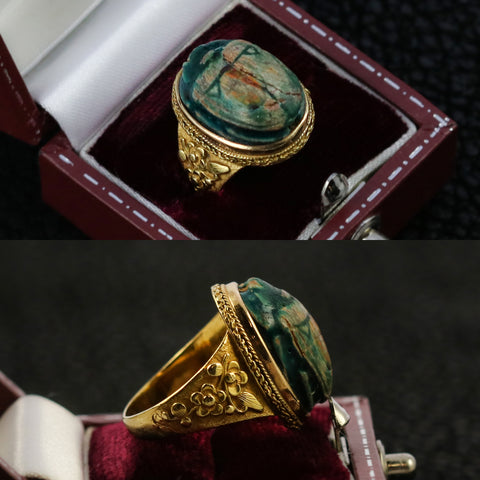
- Crescent moon: The crescent moon was associated with femininity and represented the transformative power of time. Crescent moon motifs adorned brooches, earrings, and pendants, serving as a reminder of the cycles of life and the constant evolution of one's journey.
- Horseshoe: The horseshoe was a symbol of good luck and protection. Always depicted with the open end facing upwards to catch and hold good fortune, it was seen as bad luck to have them reversed as it represented one’s luck pouring out. It was also believed that wearing a horseshoe-shaped piece would bring luck and ward off evil spirits.
- Key: The key symbolized unlocking the doors to the heart and represented love, trust, and freedom. Victorian key-shaped pendants and charms were often given as tokens of affection, representing the giver's willingness to trust and open up their heart to the recipient.
- Anchor: Representing hope and steadfastness, the anchor was often used in jewelry to symbolize stability and a safe harbor. This was an especially popular motif in jewelry worn by sailors and their loved ones, signifying their longing for a safe return from sea voyages.
- Scarab: The scarab beetle held deep significance in Victorian jewelry, representing rebirth and immortality. Inspired by ancient Egyptian mythology and influenced by a multitude of archaeological discoveries that kept the public constantly interested, scarab beetles were associated with the sun god and were believed to bring good luck and protection. Scarab motifs were intricately carved into gemstones and used in rings, pendants, and bracelets. It was also common for people to make jewelry out of authentic ancient scarab beetles, which many Egyptian merchants sold to tourists.
- Read More
- Joseph Denaburg
- /
- 0 Comment(s)

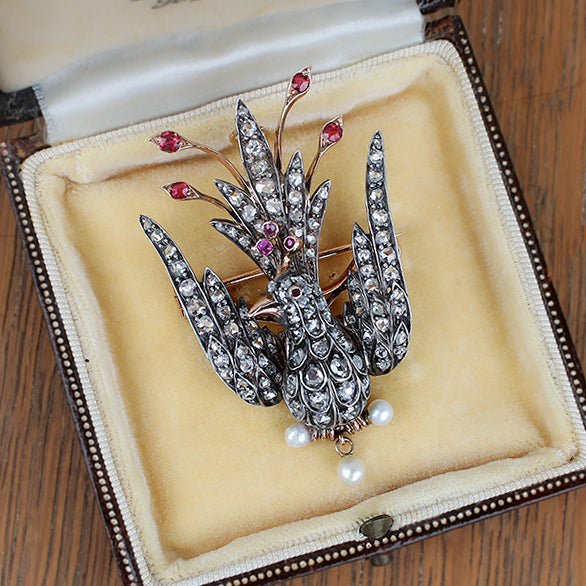
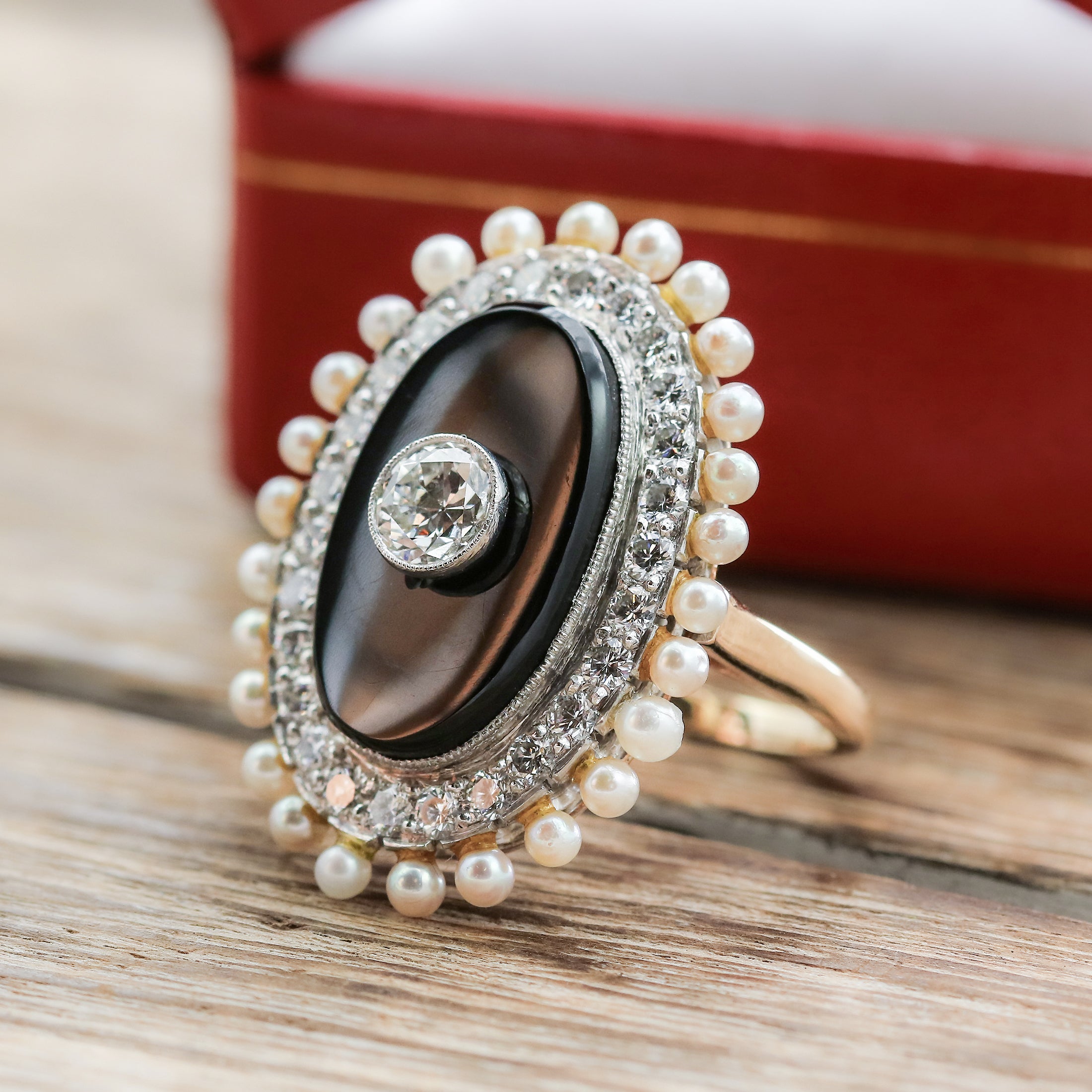
 A late Georgian/Early Victorian sterling silver seed pearl and diamond double bracelet, which can be attached and worn as a necklace.
A late Georgian/Early Victorian sterling silver seed pearl and diamond double bracelet, which can be attached and worn as a necklace.

 Victorian 15k yellow gold turquoise and seed pearl dangle earrings
Victorian 15k yellow gold turquoise and seed pearl dangle earrings
 An Art Nouveau depiction of a woman in yellow gold with a colorful enamel backing and seed pearl accents
An Art Nouveau depiction of a woman in yellow gold with a colorful enamel backing and seed pearl accents
 Victorian mourning necklace featuring onyx, black enamel and a seed pearl accent reading "In Memory of" on the front
Victorian mourning necklace featuring onyx, black enamel and a seed pearl accent reading "In Memory of" on the front
 An elaborate Victorian peridot and seed pearl necklace set in yellow gold
An elaborate Victorian peridot and seed pearl necklace set in yellow gold
 Art Nouveau enamel, peridot and seed pearl necklace created by renowned design house Krementz & Co
Art Nouveau enamel, peridot and seed pearl necklace created by renowned design house Krementz & Co
 Art Deco amethyst ring set in an elaborate filigree ring made of white and yellow gold with seed pearl accents
Art Deco amethyst ring set in an elaborate filigree ring made of white and yellow gold with seed pearl accents
